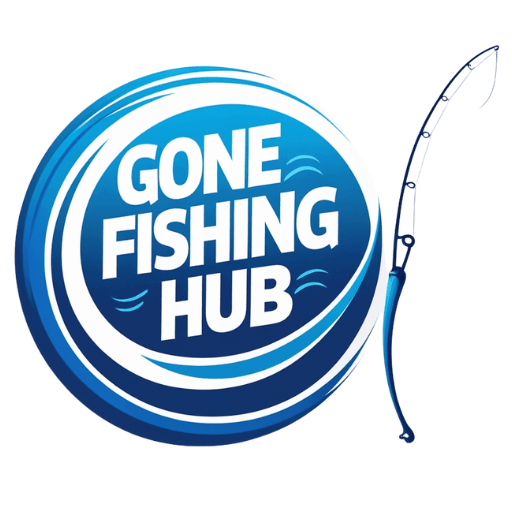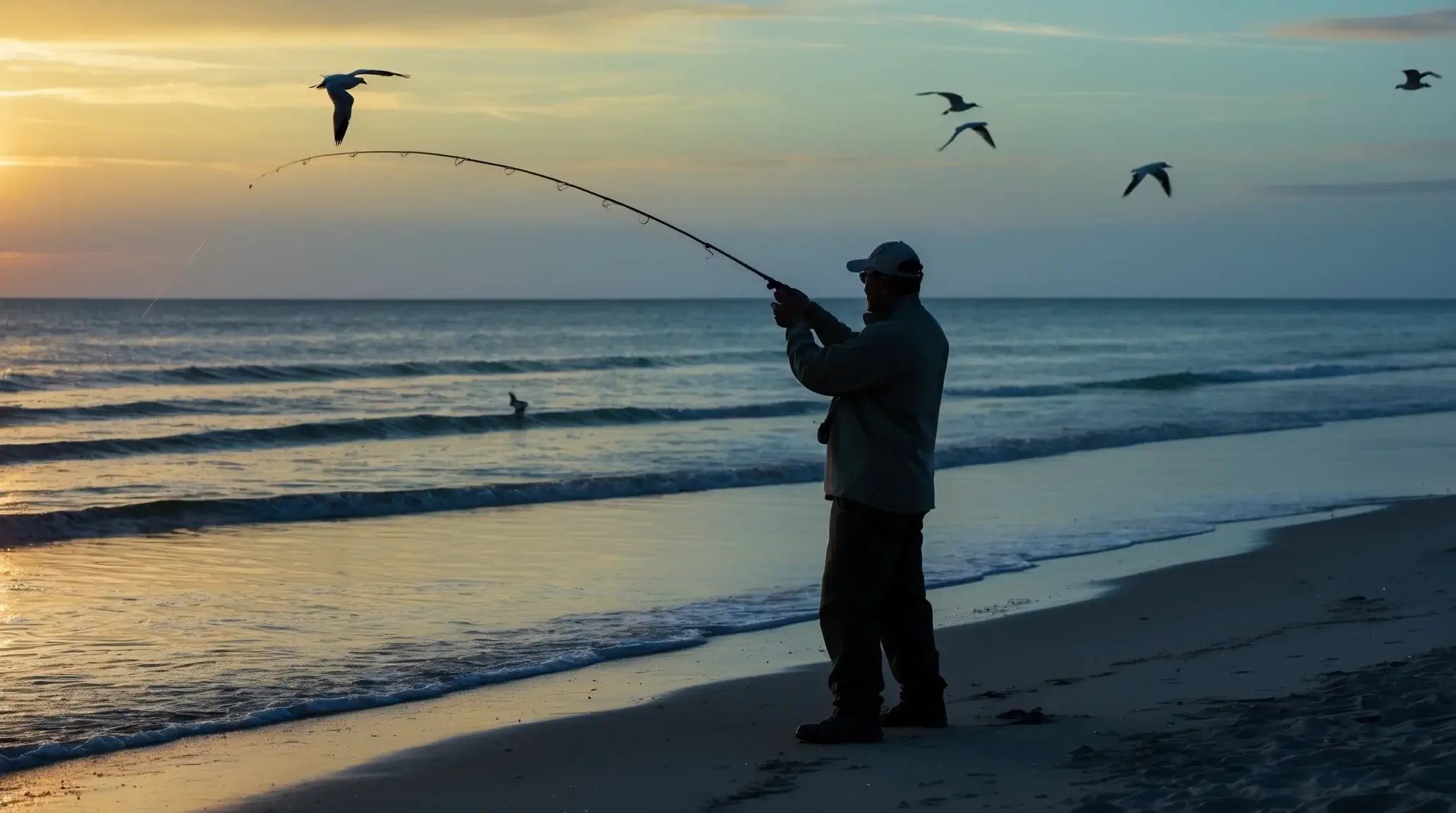Why Understanding Tide Charts is Crucial for Fishing
If you’ve ever gone fishing and felt like the fish weren’t biting, you’re not alone. Many beginners cast their lines at random times, hoping for luck. But experienced anglers know that fishing success isn’t about luck but timing. And timing is all about the tides. 🌊
Why Do Tides Matter for Fishing?
Imagine this: You wake up early, grab your fishing gear, and head to the beach. The water looks calm, the sun rises, and you’re excited. But after two hours—nothing. Meanwhile, a guy next to you keeps pulling in fish. What’s his secret? He checked the tide chart before fishing.
Tides control fish movement. When the tide rises, baitfish move closer to shore. And where baitfish go, predatory fish follow. The water pulls baitfish back out as the tide falls, creating another prime feeding time. You’ll have much better chances of success if you fish during these tidal movements.
High Tide vs. Low Tide: Fishing Conditions
| Tide Phase | Best Fishing Conditions |
|---|---|
| High Tide 🔺 | Fish move closer to shore, best near structures (rocks, docks, piers). |
| Low Tide 🔻 | Fish retreat to deeper channels; look for drop-offs and deeper holes. |
| Incoming Tide 🌊 | Baitfish move in, predators follow—one of the best times to fish. |
| Outgoing Tide 🌊 | Strong currents push baitfish out, creating ambush opportunities for predatory fish. |
How Tides Affect Fish Behavior
Fish movement is heavily influenced by tidal cycles, which dictate when and where they feed.
🎯 Rising Tide: Brings in oxygen-rich water and baitfish—perfect for species like snook and striped bass.
🎯 Falling Tide: Creates strong currents that push bait out of hiding, triggering aggressive strikes.
🎯 Slack Tide (Between Tides): Water movement slows, and fish become less active—the worst time to fish.
“Mark, a recreational angler, always fished at noon, wondering why his results were poor. After tracking the tides, he realized that predatory fish were more active during the rising tide. By shifting his fishing time to early mornings during an incoming tide, his catch rate doubled.”
The Moon’s Role in Fishing
Moon phases affect tide strength. Full and new moons bring stronger tides, increasing fish movement, while quarter moons weaken currents. Checking both the tide chart and moon phase ensures better fishing conditions.
Smart Fishing: Quick Tips for Beginners
📌 Check a tide chart before heading out and plan your trip around the best tide times.
📌 Fish when the water is moving—avoid slack tide.
📌 Watch the moon phase—bigger tides = better fishing opportunities.
📌 Look for structures like jetties, reefs, or estuaries—these attract fish at high tide.
Key Takeaway
If you learn to read a tide prediction for fishing, you’ll never waste a fishing trip again. Tides dictate fish movement, and knowing when to fish will increase your chances of a great catch. So next time you head out, check the tide first—you’ll be surprised at the difference it makes! 🎣🔥
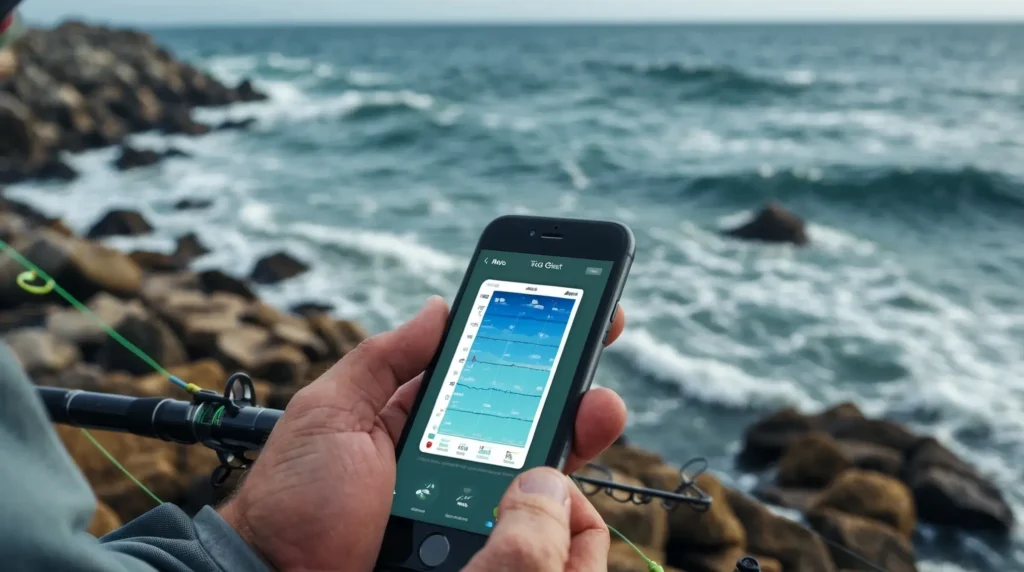
Understanding the Basics of a Fishing Tide Chart
Have you ever looked at a fishing tide chart and felt like you were reading a secret code? Don’t worry—you’re not alone! Many beginners struggle to understand tide times, heights, and tidal cycles, but once you break it down, it’s much simpler than it seems. And mastering it? That’s the key to finding the best tide times for fishing! 🎣
What Is the Best Fishing Tide Times?
A fishing tide chart is a tool that shows the predicted movement of ocean water throughout the day. It provides key information such as:
📌 Tide times – When the water will be at its highest and lowest points.
📌 Tide height – How high the water rises or falls (measured in feet or meters).
📌 Tidal range – The difference between high and low tide levels.
Understanding these details helps you predict where the fish will be and when they’ll be feeding.
How the Moon and Tides Are Connected
Have you ever heard the phrase “fishing by the moon”? That’s because the moon’s gravity controls the tides.
🌕 Full Moon & New Moon: Stronger tides, more fish movement!
🌗 Quarter Moons: Weaker tides, slower fish activity.
This is why experienced anglers check the moon phase and the tide chart before heading out!
Tide Symbols and What They Mean
When reading a tide chart, you’ll often see these symbols:
✔️ 🔼 Rising Tide (Incoming Tide): Best for active fish near the shore.
✔️ 🔽 Falling Tide (Outgoing Tide): Great for catching predators near current breaks.
✔️ ⏳ Slack Tide: The calm period between tides—not ideal for fishing.
“Three months ago, Michael, a casual angler, struggled to catch anything despite using the best lures. After tracking the tide charts for two weeks, he noticed a pattern—every time he fished one hour before high tide; he caught significantly more striped bass. He now plans every trip around the incoming tide and consistently outperforms other anglers fishing at random times.”
Pro Tips for Reading Tide Charts
📍 Use a tide chart app to get real-time updates and alerts.
📍 Look for peak tide times—fish are more active when the tide moves.
📍 Plan your fishing spot based on high or low tide.
📍 Adjust for local variations—estuaries and sandbars can delay tides by 30+ minutes.
Key Takeaway
Understanding a fishing tide chart helps you fish smarter, not harder! You’ll have a major advantage if you know when the tide is rising or falling and how the moon affects tides. So next time you go fishing, don’t just grab your rod—check the tides first! 🌊🎣
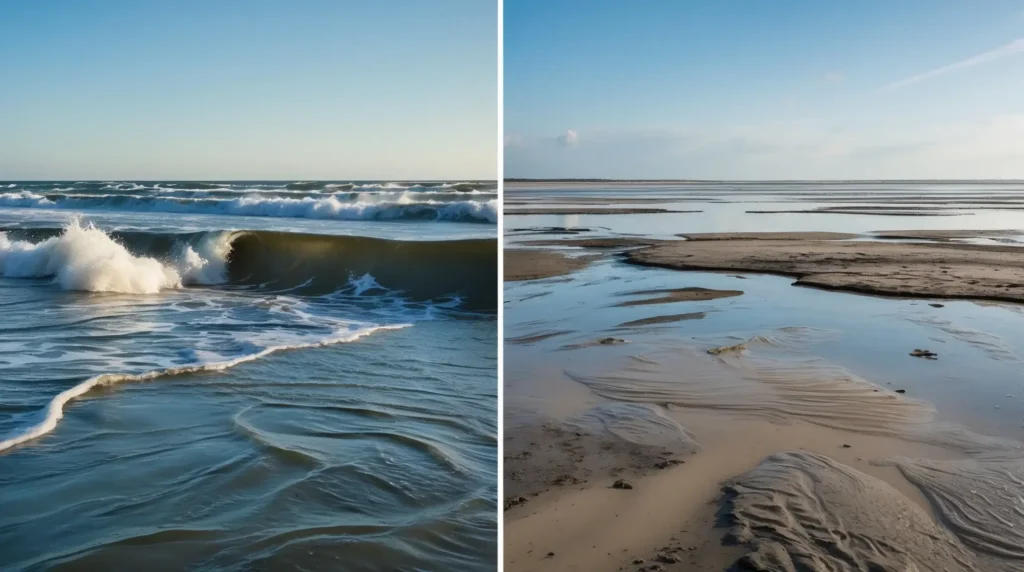
How Tides Affect Fishing – Key Factors for Anglers
Have you ever wondered why some anglers always seem to catch more fish? The secret isn’t just in the bait or the rod—it’s understanding how tides affect fishing. Knowing when fish are most active and how they move with the tide, you’ll have a better chance of landing a great catch.
How Tides Influence Fish Activity & Best Times to Fish
Why Do Fish Follow the Tides?
Fish don’t just move randomly—they follow the tide-driven food supply. Tides bring in baitfish, shrimp, and small crustaceans, attracting predators like striped bass, redfish, and snook.
During a rising tide, baitfish move closer to shore, providing excellent fishing near sandbars, jetties, and estuaries.
During a falling tide, water pulls baitfish out, creating prime hunting grounds near drop-offs and channels.
Best Tide Phases for Fishing
| Tide Phase | Best Fishing Conditions | Best Fishing Spots |
|---|---|---|
| Incoming Tide 🌊 | Baitfish move in, predators actively feed | Piers, sandbars, estuaries |
| High Tide 🔺 | Fish hunt in flooded areas | Reefs, mangroves, docks |
| Outgoing Tide 🌊 | Fish ambush prey as water recedes | Deep holes, drop-offs, channels |
| Slack Tide ⏳ | Least productive fish slow down | Deepwater zones, offshore reefs |
How Different Fish React to Tide Changes
Not all fish behave the same way!
🐟 Predatory fish (striped bass, snook, redfish) wait near current breaks and ambush prey as tides shift.
🐟 Baitfish get carried by tide-driven currents, attracting larger predators.
🐟 Bottom-feeders (flounder, catfish) move into shallow areas during high tide to hunt for food in the sand.
The Role of Water Conditions
Tides don’t just move fish—they change the water’s oxygen levels, salinity, and temperature.
📍 More oxygen = More active fish.
📍 Warm water speeds up fish metabolism, making them eat more.
📍 High salinity helps saltwater fish stay comfortable and active.
This is why weather conditions matter too—strong winds, rain, or sudden temperature drops can change how fish react to tides.
Quick Tips for Fishing with the Tides
📌 Use a tide chart to plan your fishing trips around peak movement times.
📌 Target areas with strong tidal currents, like inlets and sandbars, where fish gather.
📌 Watch for bird activity—diving seabirds means baitfish are nearby, and predators won’t be far behind.
📌 Experiment with lures and bait—fish react differently depending on tidal flow speed.
Key Takeaway
If you want to catch more fish, pay attention to the tides. Moving water = moving fish, and that means better chances of success. So before you head out, check a tide chart, plan your spot, and fish the right tide phase—it can make all the difference! 🎣🌊
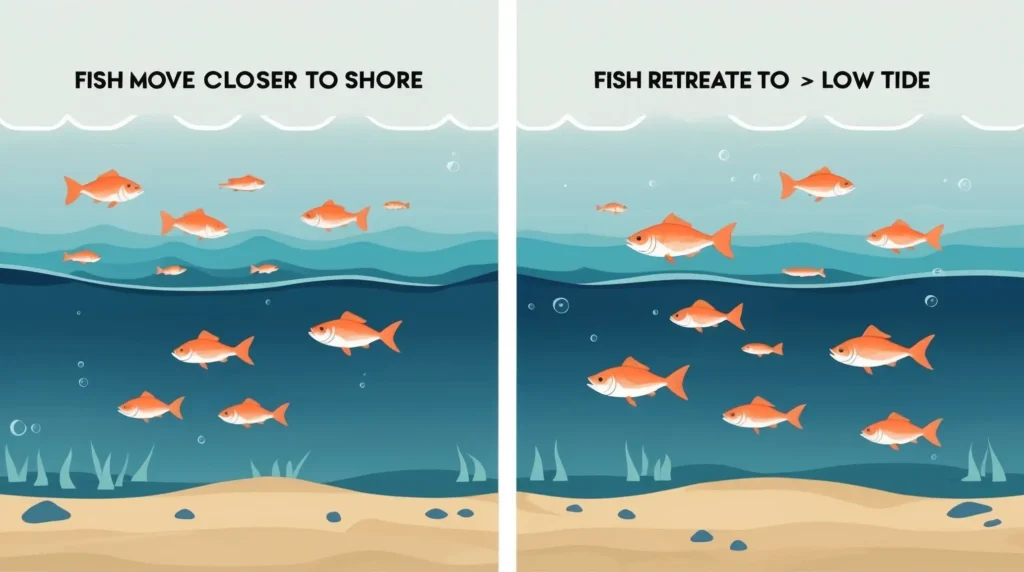
Reading Tide Charts: Step-by-Step Guide for Beginners
Have you ever looked at a fishing tide chart and felt like you were trying to decode a secret message? Don’t worry—you’re not alone! It’s easier than it looks. Once you understand the key elements, you’ll know exactly when and where to fish for the best results.
Step 1: Find a Reliable Tide Chart
Before heading out, check a tide prediction table online or use a fishing app like NOAA Tide Charts or Tides4Fishing. These sources provide:
📌 Tide times (when high and low tides occur).
📌 Tide heights (measured in feet or meters).
📌 Tidal range (the difference between high and low tide).
Step 2: Understand Tide Symbols and Readings
Here’s a simplified breakdown of what you’ll see on a tide chart:
| Time | Tide Level | Height (ft) |
|---|---|---|
| 6:00 AM | High Tide | 5.2 ft |
| 12:30 PM | Low Tide | 0.8 ft |
| 6:45 PM | High Tide | 5.5 ft |
How to interpret this chart:
- The water will be most profound at 6:00 AM and 6:45 PM—the best times to fish near reefs, piers, and estuaries.
- At 12:30 PM, the tide is low, meaning fish may move to deeper waters.
- The best fishing conditions often occur 1-2 hours before and after high or low tide when water movement is most potent.
Step 3: Adjust for Local Conditions
Tide charts provide general predictions, but local geography and weather impact tidal movements. Keep in mind:
📍 Estuaries and sandbars can delay tides by 30+ minutes—adjust accordingly.
📍 Wind and storms can push tides higher or lower than predicted.
📍 Some fishing spots experience micro-tides, meaning the tidal impact varies based on structure and depth.
Common Tide Chart Symbols & What They Mean
✔️ 🔼 Rising Tide (Incoming Tide): Best for active fish near the shore.
✔️ 🔽 Falling Tide (Outgoing Tide): Great for predators ambushing bait.
✔️ ⏳ Slack Tide: The calm period between tides—not the best time to fish.
Quick Tips for Beginners
📌 Use a GPS-based fishing app for real-time tide updates.
📌 Fish moving water—avoid slack tide when water is still.
📌 Look for patterns in tide charts—keeping a fishing journal can help identify your best spots based on past trips.
📌 Check wind conditions—strong winds can accelerate or slow down tide movements.
Key Takeaway
Reading a fishing tide chart isn’t complicated—it’s all about matching tide movements with fish activity. Using a tide chart, adjusting for local conditions, and fishing during the right tide phases, you’ll never waste a fishing trip again! 🎣🌊
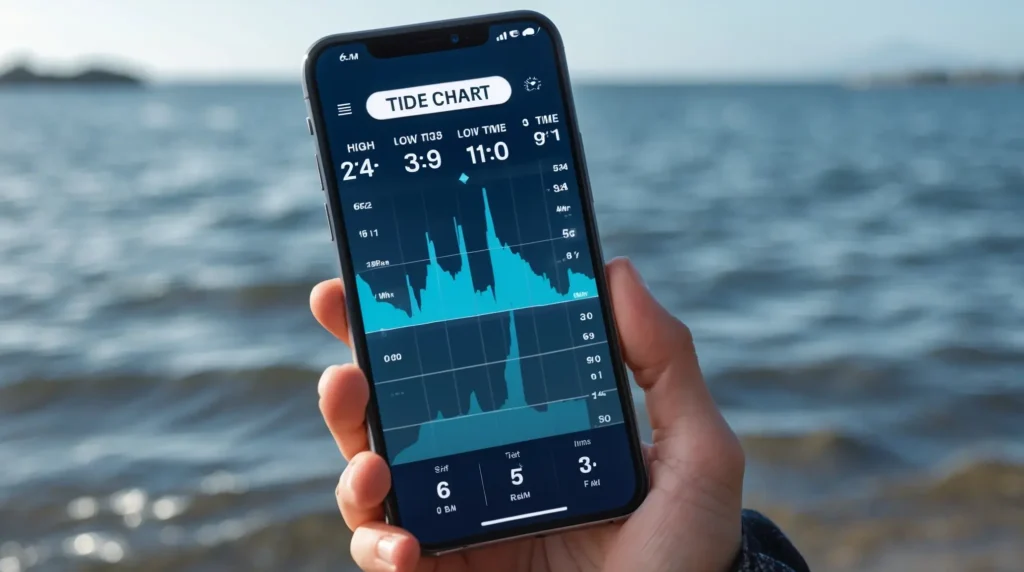
Essential Fishing Tools for Tracking and Using Tides
Fishing is about timing, location, and the right tools. If you’ve mastered Understanding tide charts for fishing, the next step is using the best gear to track tides in real-time and improve your chances of landing a great catch. Whether you prefer digital fishing apps or classic tide watches, the right tools can make a slow fishing day successful.
Must-Have Tools for Tide-Aware Fishing
1. Tide Watches ⌚
A tide watch is a wristwatch that tracks tide cycles, moon phases, and barometric pressure. Some popular brands like Casio, Garmin, and Rip Curl offer models with built-in tide predictions.
📍 Great for surf fishing—no need to check a phone.
📍 Helps predict the best tide times for fishing in different locations.
2. Fishing Apps 📲
Smartphone apps provide accurate tide predictions, weather reports, and fishing forecasts.
| App Name | Best Features |
|---|---|
| Tides4Fishing | Best for tide charts & solunar activity predictions |
| Navionics Boating | Nautical maps with GPS-based tide tracking |
| Fishbrain | Tracks local fishing reports & real-time angler data |
| NOAA Tide Charts | Reliable government-backed tide info |
📍 Best for beginners—simple, easy-to-use interfaces.
📍 Get real-time alerts when tides change.
3. Portable Depth Finders & Sonar Technology 🎣
Fish finders like Garmin Striker or Deeper Sonar use sonar technology to locate fish during incoming and outgoing tides.
📍 Works in both saltwater and freshwater.
📍 Helps identify submerged structures and fish ambush zones.
4. Nautical Charts & Weather Stations
If fishing in unfamiliar waters, a nautical chart helps you understand coastal geography, tidal currents, and sandbar exposure. A portable weather station can also track barometric pressure and wind influence—two factors that impact fishing success.
📍 Best for deep-sea fishing and offshore trips.
Brilliant Fishing: Pro Tips for Tracking Tides
📌 Use a tide-tracking app to get real-time updates before every trip.
📌 Combine a tide watch with a GPS-based fish finder for maximum efficiency.
📌 Check barometric pressure changes—a sudden drop can signal lousy fishing conditions.
📌 Look for patterns in fish activity—keep a log of successful tide phases.
Key Takeaway
Using smart fishing tools makes a huge difference. Whether it’s a tide watch, a fishing app, or a sonar depth finder, these tools help you predict fish movements and maximize your success. Fish smarter, not harder! 🎣⚡
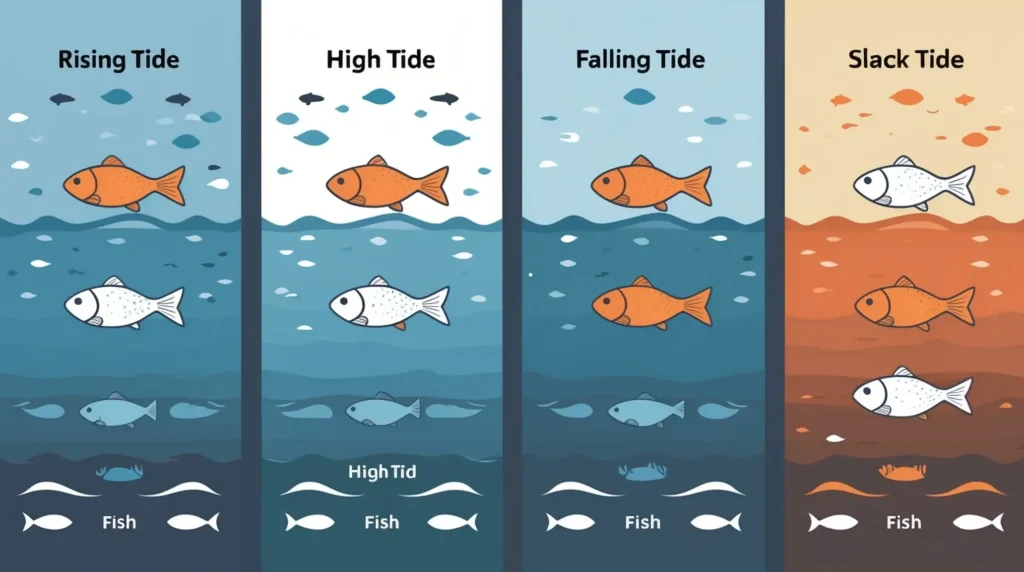
Advanced Pro Tips for Fishing Tidal Waters Based on Tides
Fishing in saltwater isn’t just about casting a line—it’s about reading the tides and understanding fish behavior. Experienced anglers use tides to their advantage, targeting specific areas where fish naturally gather during different tide phases. By using the right tide-driven strategies, you can increase your chances of landing a great catch.
Where to Fish During Different Tide Phases
Tides influence fish movement, and knowing where to find them is key.
| Tide Phase | Best Fishing Conditions | Best Fishing Spots |
|---|---|---|
| Incoming Tide 🌊 | Baitfish move in, predators start feeding | Sandbars, inlets, mangroves |
| High Tide 🔺 | Fish move into flooded zones to hunt | Reefs, tidal flats, submerged structures |
| Outgoing Tide 🌊 | Predators ambush bait as water drains | Drop-offs, estuaries, deepwater transitions |
| Slack Tide ⏳ | Water movement slows, and fish become inactive | Offshore reefs, deep channels |
Pro Techniques for Saltwater Fishing Success
1. Target Tidal Feeding Zones 🎯
During an incoming tide, baitfish move toward sandbars and inlets, attracting predatory fish like snook, redfish, and tarpon. To maximize success:
📍 Use live bait or soft plastics to match the natural food source.
📍 Position yourself near rip currents or tidal outflows, where fish gather.
2. Fish Near Submerged Structures at High Tide 🏝️
When the tide is high, fish move into reefs, mangroves, and tidal flats to feed. This is the perfect time for topwater lures or baitfish imitations.
📍 Cast near structures—fish wait in cover, ambushing prey.
📍 Watch for diving birds—they signal baitfish activity.
3. Outgoing Tide = Ambush Time 🦈
Fish gather near deepwater transitions, and currents break as water drains out to catch baitfish.
📍 Use jigs or cut bait near channel edges where fish wait for an easy meal.
📍 Slow retrieval works best—fish are positioned to grab passing bait.
Expert Tips for Maximizing Tide-Based Fishing
📌 Use a tide-tracking app—know precisely when each tide phase occurs.
📌 Pay attention to water clarity—some fish prefer clear water during high tide and murkier conditions during outgoing tides.
📌 Adjust your lure depth—predatory fish change depth depending on tide flow.
📌 Try night fishing during strong tides—certain species feed more aggressively under a full moon and high tide.
Key Takeaway
Saltwater fishing is all about timing and location. If you learn how to read a fishing tide chart and adapt your strategy to tidal movement, you’ll increase your catch rate significantly. Fish the right spots at the right tide—and watch your success soar! 🎣🌊
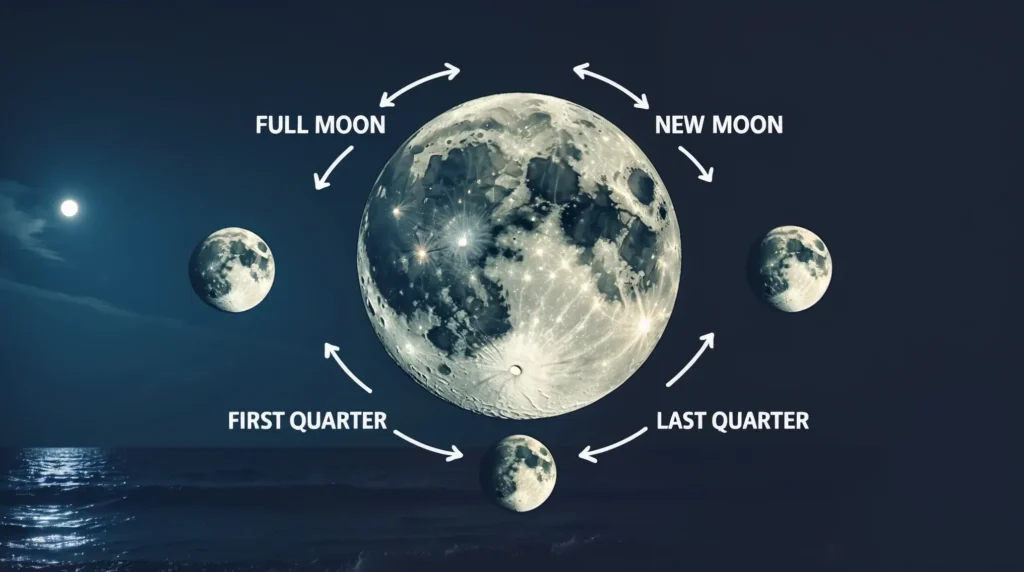
Knowing how to read a fishing tide chart can make all the difference in your fishing success, especially in tidal waters.
Common Mistakes When Reading a Tide Chart & How to Avoid Them
Reading a fishing tide chart seems straightforward—until you realize you’ve misread the tide time and arrived at your spot when the fish aren’t biting! Many beginners make avoidable mistakes that can ruin a fishing trip. Let’s break down the most common errors and how to prevent them.
1. Misreading Tide Times & Conversions
One of the biggest mistakes is misinterpreting tide times or not adjusting for time zones. Tide charts are often based on the nearest major port, but if you’re fishing in a bay, estuary, or river, the tide could be delayed by 30 minutes or more.
📍 Check if the tide chart is in local time or needs adjustments.
📍 Use a GPS-based tide chart app for real-time accuracy.
2. Ignoring Local Variations
Tides don’t behave the same everywhere! Factors like coastal terrain, river mouths, and seasonal changes can shift tide schedules and alter water depth predictions.
📍 Check tide predictions for your fishing spot—not just the nearest port.
📍 Account for tide delay factors caused by rivers, bays, and sandbars.
3. Failing to Consider Weather & Moon Phases
Tides aren’t the only factors that affect fish behavior—wind, storms, and moon phases also play a big role.
📍 A full moon brings higher tides, meaning stronger currents and better fishing.
📍 Strong onshore winds push tides in earlier than expected, while offshore winds can delay them.
📍 Sudden storms or air pressure drops can make fish less active, even if the tide looks perfect.
4. Fishing During Slack Tide
Many beginners make the mistake of fishing when the tide isn’t moving. Slack tide—the period between high and low tide when the water is nearly still—is generally the worst time to fish because fish become less active.
📍 Plan to fish 1-2 hours before and after high or low tide when water movement is most potent.
5. Ignoring Depth & Current Strength
Tide charts show how high or low the tide will be but don’t always indicate the current speed. Faster currents during strong tides can make fishing harder in some locations.
📍 If the current is too strong, fish may move to deeper, calmer areas. Adjust your strategy accordingly.
“Jake and his friends planned a surf fishing trip to catch redfish. They checked the tide chart but didn’t account for local variations—fishing in a bay instead of the main tide station location. When they arrived, the tide was already outgoing instead of rising. The result? No fish, despite using the right bait and gear. After adjusting for the bay’s 45-minute tide delay on their next trip, they landed multiple redfish within an hour.”
Quick Fixes to Avoid These Mistakes
📌 Double-check tide times & location—don’t assume tides are the same everywhere.
📌 Use a tide-tracking app that provides real-time updates on tide movement.
📌 Watch weather conditions—primarily wind and air pressure changes.
📌 Avoid slack tide—focus on when the water is actively moving.
Key Takeaway
A small mistake in reading a tide chart can mean the difference between a great catch and a wasted trip. Check local conditions, adjust for weather, and always confirm tide times before heading out. Learn from these common errors, and you’ll never reappear at the wrong time! 🎣🌊
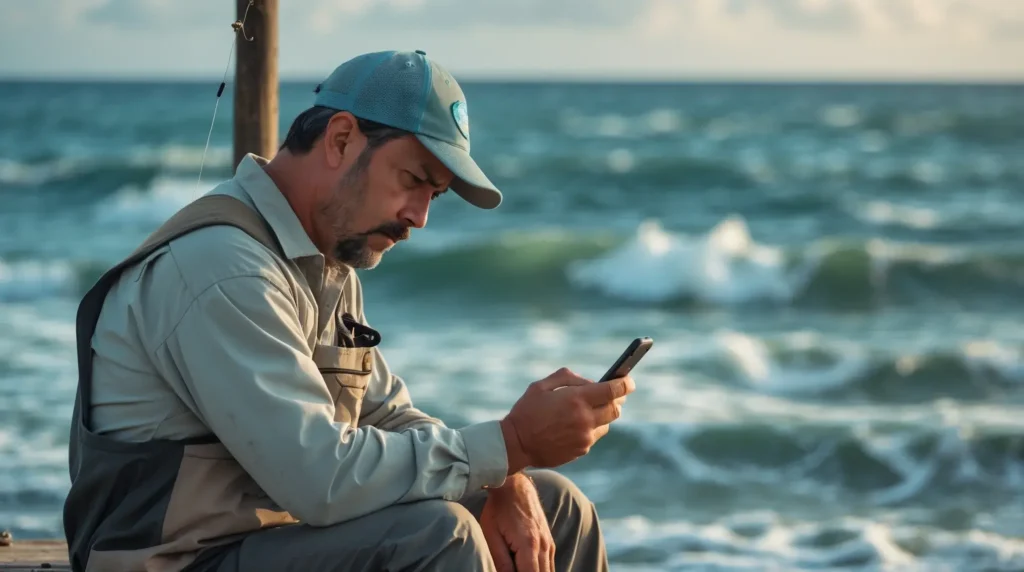
Conclusion: Mastering Tide Charts for Better Fishing
By now, you’ve learned that reading a fishing tide chart can completely change your fishing game. From identifying optimal tide phases for anglers to using tide-driven strategies, every skilled angler knows that timing is everything.
Key Takeaways: What You’ve Learned
📍 Tides control fish behavior—knowing when fish feed gives you an advantage.
📍 Incoming tides bring baitfish in while outgoing tides pull them out—plan accordingly!
📍 Using tide charts and fishing apps helps predict the best bite times.
📍 Weather, moon phases, and local conditions affect tide accuracy—always check real-time updates.
📍 Avoid common mistakes, like misreading tide times or ignoring local variations.
Your Next Steps: Becoming a Tide-Savvy Angler
🎣 Plan your next trip using a tide chart—choose a fishing spot and match it with the best tide phase.
🎣 Experiment with different tide phases—track what works best in your location and for your target species.
🎣 Use technology! Download a tide-tracking app or invest in a tide watch to stay ahead.
🎣 Check local fishing reports—learn from experienced anglers in your area.
Final Thought: Fish Smarter, Not Harder
Fishing isn’t just about luck—it’s about strategy and knowledge. Using a tide chart, watching the weather, and choosing the right conditions, you’ll catch more fish and waste less time.
Next time you plan a fishing trip, check the tides first. Set a reminder to review a tide chart the night before, plan your spot accordingly, and track your results. The more you apply tide-based fishing strategies, the more successful your trips will be! 🌊🎣
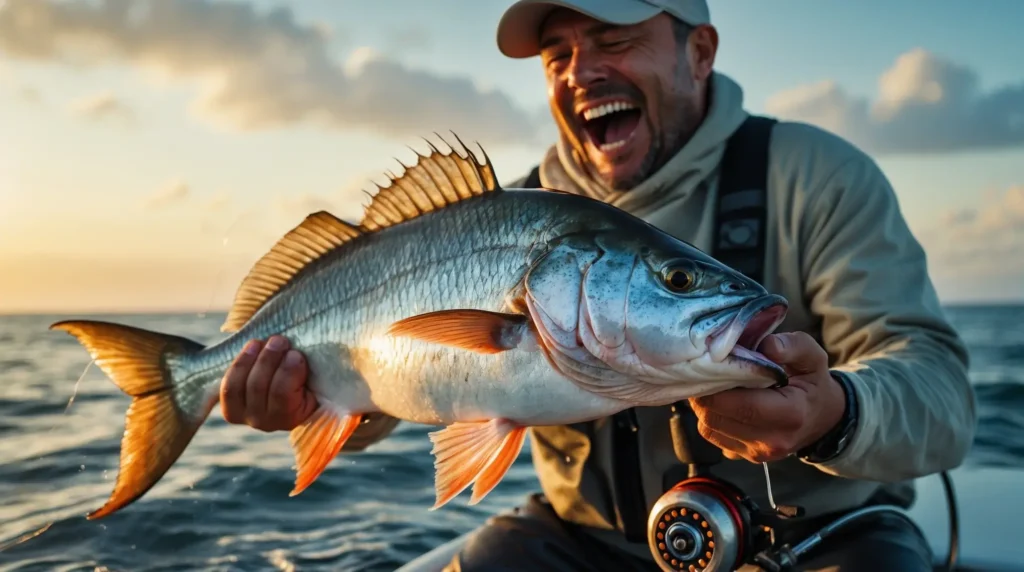
If you’re planning a trip to Florida, knowing the best fishing spots can help maximize your chances of a great catch.
FAQ: Understanding Tide Charts for Fishing
Understanding how to read a fishing tide chart is essential for any angler, whether you’re a beginner or an experienced fisherman. Here are answers to the most frequently asked questions about fishing tides, best fishing times, and common tide chart mistakes.
What is a fishing tide chart, and why do I need one?
A fishing tide chart shows the predicted times for high and low tides and tidal heights at specific locations. Fish move with the tides, so using a tide chart helps you fish at the best times when fish feed actively.
What’s the best tide for fishing?
The best time to fish is usually during an incoming or outgoing tide. This is when baitfish move the most, attracting predators. Slack tide (when the water is still between high and low tides) is typically the least productive.
How do I read a tide chart correctly?
A tide chart includes:
📌 Tide times (high and low tide).
📌 Tide height (measured in feet or meters).
📌 Moon phase and tidal range, which impact fish activity.
Match your fishing time with a rising or falling tide for the best results.
How far in advance can I trust a tide chart?
Tide charts are accurate for weeks or months in advance, but weather conditions, wind, and atmospheric pressure can cause slight variations. Always check real-time tide updates before heading out.
Does the moon phase affect fishing?
Yes! Full and new moons create stronger tides, which means more fish movement and better feeding conditions. Many anglers prefer to fish around these moon phases for the best chances of success.
What’s the difference between high tide and low tide fishing?
Tide Phase Best Fishing Conditions
High Tide 🔺 Fish move into shallow areas near structures (reefs, piers, mangroves).
Low Tide 🔻 Fish retreat to deeper water. Look for drop-offs and channels.
Incoming Tide 🌊 Baitfish move in, and predators follow. One of the best times to fish!
Outgoing Tide 🌊 Predators wait near current breaks to ambush baitfish.
Can weather affect tide predictions?
Absolutely! Strong winds and storms can shift tide times, making them arrive earlier or later than expected.
📍 Onshore winds push tides higher and faster.
📍 Offshore winds can delay tides or make them weaker.
📍 A sudden drop in barometric pressure often leads to poor fishing conditions as fish become less active.
Do I need a tide chart if I fish in freshwater?
Not always. Tides mainly affect saltwater fishing. However, where freshwater rivers meet the ocean (estuaries, tidal rivers), tides still play a significant role in fish movement.
What’s the most significant mistake anglers make when using tide charts?
One of the most common mistakes is not adjusting for local variations. Tide times listed on a chart are usually for major ports, but if you’re fishing in a bay, inlet, or river, tides could be delayed by 30 minutes or more.
📌 Always check localized tide data for your exact fishing spot.
Are there apps for checking tide charts?
Yes! Many tide-tracking apps provide real-time data, weather forecasts, and fishing predictions. Here are some popular ones:
App Name Best Features
Tides4Fishing Tide charts + fish activity predictions
NOAA Tide Charts Government-backed accurate tide data
Navionics Boating Nautical maps + real-time tide tracking
Fishbrain Community-based fishing reports & tide info
Before your first trip, make sure you have the basics covered by reading our beginner’s guide to fishing.
Key Takeaway
Mastering tide charts will transform the way you fish. Instead of guessing when to cast your line, you’ll have a clear strategy based on real data. Start using a tide-tracking app, log your results, and adjust your fishing schedule accordingly. The difference will be night and day! 🎣🌊
